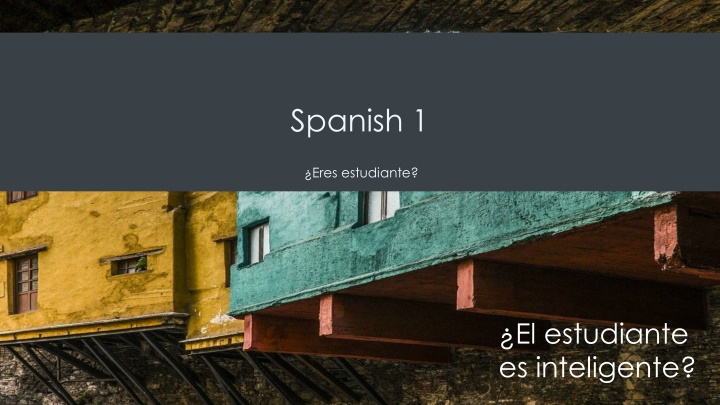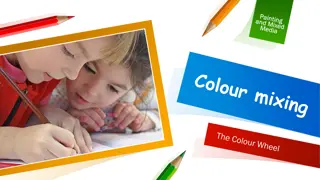Spanish 1: Learning Adjectives and Colors
In this Spanish 1 course, students will learn about adjectives and colors to describe nouns in both gender and number forms. The lessons cover the identification of colors, recognizing the correct position, gender, and number of adjectives, as well as identifying objects based on spoken descriptions. Students engage in activities to practice vocabulary related to colors and common adjectives, along with learning about adjective agreement with nouns. The course emphasizes interactive learning through activities like identifying colors in the classroom and practicing adjective agreement in Spanish sentences.
Download Presentation

Please find below an Image/Link to download the presentation.
The content on the website is provided AS IS for your information and personal use only. It may not be sold, licensed, or shared on other websites without obtaining consent from the author.If you encounter any issues during the download, it is possible that the publisher has removed the file from their server.
You are allowed to download the files provided on this website for personal or commercial use, subject to the condition that they are used lawfully. All files are the property of their respective owners.
The content on the website is provided AS IS for your information and personal use only. It may not be sold, licensed, or shared on other websites without obtaining consent from the author.
E N D
Presentation Transcript
Spanish 1 Eres estudiante? El estudiante es inteligente?
Learning Outcomes: El estudiante es inteligente? 2.4.1: Identify the color of things. 2.4.2: Recognize the correct position, gender and number of adjectives. 2.4.3: Identify things based on spoken descriptions.
Introduction to El estudiante es inteligente? The colors are words that help us describe something. On the other hand, adjectives modify a noun providing more detail about them or about the pronouns. It might provide a color or a description: The red ball. The house is magnificent. (adjective following the linking verb is ) Note: adjectives only modify nouns or pronouns. To modify verbs, we use adverbs, but we'll get to that in later chapters. As we ll see, adjectives in Spanish behave slightly differently from those in English.
Actividad de calentamiento 1 Cu les colores sabes? Rojo Naranja Amarillo Azul Verde Morado
Vocabulario: Los colores Azul claro Rosado Azul oscuro Marr n Gris Negro Blanco
Actividad: De qu color es? Mira tu sala de clase y pregunta a tu compa ero de qu colores son diferentes objetos (Look at your classroom and ask your partner what color different objects are). Modelo: Estudiante 1: De qu color es la pizarra? Estudiante 2: La pizarra es verde.
Vocabulario: Algunos adjetivos f cil (easy) dif cil (difficult) paciente/ impaciente idealista/realista optimista/pesimista sociable ego sta (selfish) interesante (interesting) inteligente importante grande (big) amable (nice) feliz (happy) alegre (joyful)
Concordancia de adjetivos You learned in previous lessons that nouns and articles in Spanish must agree in both gender (masculine or feminine) and number (singular or plural). This same agreement must occur in Spanish when adjectives are used to describe nouns. If the noun is masculine and singular, the adjective that describes the noun will also be masculine and singular: If the noun is masculine and plural, the adjective that describes the noun will also be masculine and singular: el chico generoso (the generous boy) los chicos generosos (the generous boys) If the noun is feminine and singular, the adjective that describes the noun will also be feminine and singular: If the noun is feminine and plural, the adjective that describes the noun will also be feminine and plural: la chica generosa (the generous girl) las chicas generosas (the generous girls)
Concordancia de adjetivos (cont.) If an adjective ends in -o for the masculine form, it generally will also have a feminine form (generoso / generosa as shown in the examples). If a masculine singular adjective ends in a consonant or a vowel other than -o (most commonly -e), such as importante, it does not change for gender, but it will change for number. The plurals of adjectives are formed in the same way that you learned in previous lessons for nouns. Add an -s if the word ends in a vowel; add an -es if the word ends in a consonant. el documento importante la clase importante los documentos importantes las clases importantes
Ejercicio Fill in the blank with the form of the adjective that agrees in number and gender with the noun. 1. Los perros son _____ (short). 2. Las ventanas son _____ (round). 3. El libro de texto es muy _____ (heavy). 4. La jirafa _____ (tall) est en el jard n. 5. Necesito tres l pices _____ (blue). 6. Tengo _____ (some) sillas _____ (heavy).
Posicin de los adjetivos Adjectives are usually placed after the noun they are describing or after the verb ser. Mi mam cocina comida rica. (My mom cooks delicious food.) Los m dicos son inteligentes. (The doctors are intelligent.) Indefinite adjectives, such as mucho (a lot, many), alguno (some), ninguna (any), cada (every) and numbers, both cardinal and ordinal, precede the noun.
Practice Question 1 C mo es el p jaro? A. antip ticas B. antip tico C. antip ticos D. antip tica
Practice Question 2 C mo es la mesa? A. redonda B. redondas C. redondo D. redondos
Practice Question 3 Mi hermano tiene ojos _____. A. verde B. moradas C. verdes D. morada
Practice Question 4 El pelo de su perro es de color _____. A. azul B. morado C. morada D. marr n
Quick Review What words are used for colors and to describe things? How do adjectives change for gender and number agreement? How is word order different in Spanish than it is in English with respect to adjectives? How can placement of some adjectives affect their meaning?























